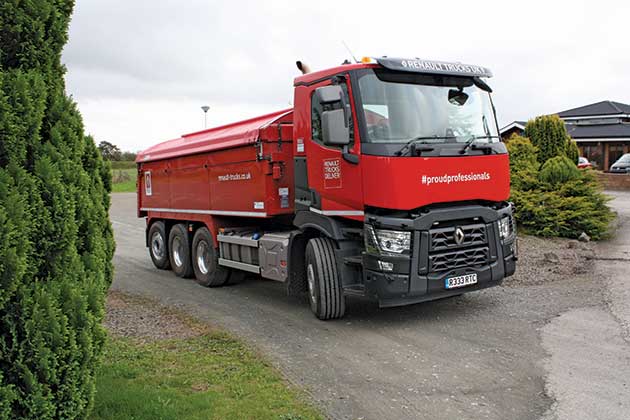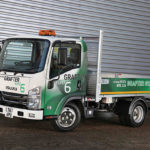
Better lateral movement and smaller turning circles are enticing more operators to give the tridem spec truck a go, so understanding just what this type of truck can give you is important. Kevin Swallow spent the day in the Scottish Borders behind the wheel of Renault’s C Tridem.
TWO YEARS ago, Renault Trucks put its first, eight wheel Tridem into service in the UK. Launched in Europe the previous year, it’s based on a 6×4 chassis with the option to add a rear axle and take up from operators has been encouraging (see operator’s verdict).
In the bulk haulage and construction markets, those moving from three axles and 26 tonnes gross vehicle weight (GVW) to four axles and 32 tonnes GVW meant a choice of traditional 8×4 or 8×2 rear steer. Double drive is still bread and butter for tipper operators who work in muckaway, aggregate and asphalt markets, whereas single drive with a rear steer suits the utilities, local authority, milk collection, biomass and animal feed markets.
Choosing a tridem for your operation means understanding what it can give you. It offers greater manoeuvrability, smoother lateral movement and it means you can access tighter workplaces. It’s further enhanced by raising the rear axle for slow vehicle movements.
Measured kerb to kerb, Renault’s Tridem needs 7.78m to complete the sweep, while 10.3m is required with the traditional 8×4 chassis. That is a 32% difference. Anecdotally operators also cite the longer service life of tyres as they suffer less scrub with the tridem set up.
There is also the question of weight. Tridem is around 200kg heavier than a conventional 8×4, so while you gain in one area you lose in another, albeit marginally. What is more, just about all the payload on a tridem sits through the rear three axle bogie, so when it’s loaded the driver needs to be careful not to overload the front axle.
For this test, Renault supplied its C430 8×4 Tridem chassis cab with a PPG insulated body and EdBro tipping gear. The engine is the DTI11 10.8 litre 6 cylinder in-line diesel engine, with common rail high pressure fuel injection, and overhead camshaft. To achieve Euro 6 emissions it combines exhaust gas recirculation (EGR) and selective catalytic reduction (SCR).
Badged as a 430, its true horsepower rating is 424hp from 1,700-1,900rpm. Options include the 380 or the 460 badged engines. Peak torque is 2,050Nm from 1,000 to 1,400rpm, and helping to turn that power into motion is the Optidriver AT2612F direct top 12 speed transmission. Gear ratios go from 14.94:1 for first through to a direct top, and the rear axle ratio is 3.89:1.
There is currently one caveat, as you can only get the tridem with hub reduction drive axles thanks to the type of suspension it comes with. This serves operators that require more ground clearance for off road pursuits and the hub gearing allows the axle half shafts to drive the same power, but at reduced torque for both off road work and working in undulating environments.
The downside is high revving at 56mph; it sits at a whopping 1,778rpm, which is well outside the green band for fuel economy and the peak torque band. Should you require single reduction drive bogie for mainly aggregate and asphalt work then you’ll have to revert to the standard 8×4 chassis configuration, which delivers 56mph at a more fuel friendly 1,400rpm.
Secondary braking is achieved from the Optibrake, which combines the exhaust brake and valve compression brake and delivers 300kW at 2,300rpm.
The tridem chassis is 5.05m long from the front axle to the third, and its overall length is 9.61m. Without the PPG bodywork or driver and with full fuel and AdBlue tanks, the day cab chassis adds up to 10,249kg.
Transport News’ construction route is a rural affair that takes in meandering roads on the A7 north from Carlisle. There are some tight places along the route, for example, at Skipper’s Bridge before Langholm and then at Selkirk. And it was in these situations that the benefit of running a tridem becomes abundantly clear.
Conventional eight wheelers need a wide berth to get around the tight bends, and often it can be to the detriment of oncoming traffic or slow you down if you need to give way. Not so with a rear steer tridem. Both the bridge, and tight left hander in Selkirk that takes you from Tower Street into the High Street were taken within the confines of the left hand side of the road.
Tridem handles effortlessly, which allows the driver to concentrate on driving. What did stand out was the problems of trekking along at only 40mph on a single carriageway A road. Some sections of the A road network warrant it for safety, but many other sections do not. With the revs sitting a little lower at 40mph, the automated transmission feels like a coiled spring ready to respond when any ascent is met, and there are plenty of those to tackle on this route.
A positive aspect is that the driveline is happy to lug down to 1,000rpm when given a chance. We switched to manual override a couple of times to let the engine work. Perhaps the best example is the steady climb north on the A7 out of Hawick. We worked 9th, 10th and 11th gears by dropping into 1,050rpm each time at the base of each torque band to let the truck build up momentum with torque rather than power.
It was pleasing to see how the 10.8 litre engine, not the usual choice for operators covering the Scottish Borders who prefer something beefier, work its way back up to the national speed limit.
While the engine works proficiently there is at 40mph plenty of to-ing and fro-ing between 11th gear and top as the truck navigates the undulating terrain. For more oomph in 11th gear you’ll run at around 1,300rpm and once it levels off or descends you drop into top gear where it works at a tad below 1,000rpm. All this hampers progress.
NATIONAL SPEED LIMIT
There is a marked difference south of the border. Here the national speed limit is 50mph and the engine sits happily at 1,250rpm in top gear. Even though this section is no less hilly, there were many fewer changes and the engine stood a chance of climbing the shorter ascents in top gear, without changing down and slowing progress.
It’s also worth praising the design of the wing mirrors, especially on the driver’s side as it has a split between the main mirror and the blind spot mirror at the top allowing the driver a clear view of oncoming traffic; useful at junctions and roundabouts!
Renault fitted its day cab to this test vehicle. While few drivers like this type of cab, there is enough space in this vehicle for personal protective equipment (PPE) and a bag or two, without it feeling as though it might burst at the seams. There is a central storage box by the drivers left elbow, which has decent cup holders at the front of it.
Part of the test is about the driver too, so when Carlisle appears on the horizon it’s a viable question just how relaxed the driver is at the end. If fraught, it usually suggests it’s been a tough experience with too much activity; if relaxed, it reflects positively on the trucks comfortable handling and the decisions it makes to cope with the terrain. For me, Renault’s Tridem falls well into the ‘relaxed’ zone. It’s as smooth a drive as you’ll find in a multi-axle rigid. Tridem takes plenty of pain out of the lateral movement and helps keep greater lane discipline, especially on the tight corners.
There are several questions for any operator looking to invest in a tridem, and that is how important it is being able to better access tighter locations, where the truck might work against its kerbweight, hub reduction axles and cost. It’ll add up to 2% to the asking price. And would loading all the ballast to the rear of the body over the three axle bogie suit your operation?
One area of doubt that was cleared up was the performance of the 10.8 litre engine. While it lacks the energy of the 12.8 litre, the smaller power plant was no slouch. It works the climbs well, and was only really hampered by the Scottish national speed limit for single carriageway A roads.
Operator’s Verdict
MANOEUVRABILITY is the word that stands out from the testimonials given by Renault Tridem customers. Keith Wiles, managing director, of Alien Concrete & Transport bought his first tridem eight wheeler to operate on construction sites.
Based in Manchester, the Range C430 Tridem 8×4 chassis is fitted with a 9cu.m Putzmeister concrete mixer body and delivers to major construction sites across the country. He said: ‘With a tighter turning circle than conventional eight wheelers, it saves valuable time when manoeuvring. We need good versatility on site, and in tight spaces our standard eight wheelers can struggle, but the Range C Tridem allows us to run a larger capacity drum with all the manoeuvrability of a 6×4 to places not normally accessible with an eight wheeler.’
Somerset based aggregates and sand supply specialist RH & AJ Bateman was the first to order a Renault Tridem of any spec in the UK. Its Range C460 Tridem 8×4 tipper also has the rear steer and lift axle together with an Aliweld insulated tipper body.
Director Russell Bateman said: ‘The Tridem gives us extra load capacity, which helps with the profitability of our business and, crucially, it gives us better manoeuvrability and accessibility into more challenging places where an eight wheeler would usually struggle, for example, accessing equestrian arenas at the back of properties.’
He added: ‘The tridem was a bit of an experiment for us as we’ve previously had a drawbar, but it’s already been used for everything and been everywhere. It’s performed really well and overall we’ve been really happy with the investment.’




